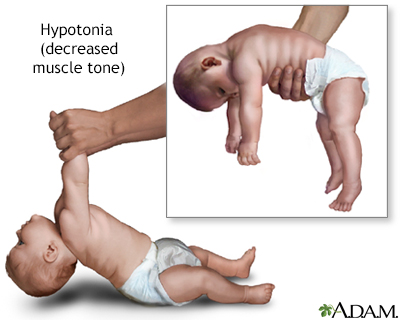Menkes disease
Menkes disease is a genetic disorder in which the body has a problem absorbing and distributing copper to bodily organs. The disease affects development, both mental and physical.
Causes
Menkes disease is caused by a defect in the ATP7A gene. The defect makes it hard for the body to properly distribute (transport) copper throughout the body. As a result, the brain and other parts of the body do not get enough copper, while it builds up in the small intestine and kidneys. A low copper level can affect the structure of bone, skin, hair, and blood vessels, and interfere with nerve function.
Menkes syndrome is usually inherited, which means it runs in families. The gene is on the X-chromosome, so if a mother carries the defective gene, each of her sons has a 50% (1 in 2) chance of developing the disease, and 50% of her daughters will be a carrier of the disease. This kind of gene inheritance is called X-linked recessive.
X-linked recessive
Sex-linked diseases are passed down through families through one of the X or Y chromosomes. X and Y are sex chromosomes. Dominant inheritance occur...

In some people, the disease is not inherited from their parents. Instead, the gene defect occurs at the time the baby is conceived.
Symptoms
Common symptoms of Menkes disease in infants are:
- Brittle, kinky, steely, sparse, or tangled hair
- Pudgy, rosy cheeks, sagging facial skin
- Feeding difficulties
- Irritability
- Decreased muscle tone (hypotonia), floppiness
- Low body temperature
Low body temperature
Hypothermia is dangerously low body temperature, below 95°F (35°C).
 ImageRead Article Now Book Mark Article
ImageRead Article Now Book Mark Article - Intellectual disability and developmental delay
- Seizures
Seizures
A seizure is the physical changes in behavior that occurs during an episode of specific types of abnormal electrical activity in the brain. The term ...
 ImageRead Article Now Book Mark Article
ImageRead Article Now Book Mark Article - Skeletal changes
Exams and Tests
Once Menkes disease is suspected, tests that may be done include:
- Ceruloplasmin blood test (substance that transports copper in the blood)
Ceruloplasmin blood test
The ceruloplasmin test measures the level of the copper-containing protein ceruloplasmin in the blood.
 ImageRead Article Now Book Mark Article
ImageRead Article Now Book Mark Article - Copper blood test
Blood test
The ceruloplasmin test measures the level of the copper-containing protein ceruloplasmin in the blood.
 ImageRead Article Now Book Mark Article
ImageRead Article Now Book Mark Article - Skin cell culture
- X-ray of the skeleton or x-ray of the skull
- Gene testing to check for defect of the ATP7A gene
Treatment
Treatment usually only helps when started very early in the course of the disease. Injections of copper into a vein or under the skin have been used with mixed results and depend on whether the ATP7A gene still has some activity.
Support Groups
More information and support for people with Menkes syndrome and their families can be found at:
- National Organization for Rare Disorders -- rarediseases.org/rare-diseases/menkes-disease/
- NIH Genetic and Rare Diseases Information Center -- rarediseases.info.nih.gov/diseases/1521/menkes-disease
Outlook (Prognosis)
Most children with this disease die within the first few years of life.
When to Contact a Medical Professional
Talk to your provider if you have a family history of Menkes syndrome and you plan to have children. A baby with this condition will often show symptoms early in infancy.
Prevention
See a genetic counselor if you want to have children and you have a family history of Menkes syndrome. Maternal relatives (relatives on the mother's side of the family) of a boy with this syndrome could be seen by a geneticist to find out if they are carriers.
Reviewed By
Anna C. Edens Hurst, MD, MS, Associate Professor in Medical Genetics, The University of Alabama at Birmingham, Birmingham, AL. Review provided by VeriMed Healthcare Network. Also reviewed by David C. Dugdale, MD, Medical Director, Brenda Conaway, Editorial Director, and the A.D.A.M. Editorial team.
Kwon JM. Neurodegenerative disorders of childhood. In: Kliegman RM, St. Geme JW, Blum NJ, Shah, SS, Tasker RC, Wilson KM, eds. Nelson Textbook of Pediatrics. 21st ed. Philadelphia, PA: Elsevier; 2020:chap 617.
Turnpenny PD, Ellard S, Cleaver R. Inborn errors of metabolism. In: Turnpenny PD, Ellard S, Cleaver R, eds. Emery's Elements of Medical Genetics and Genomics. 16th ed. Philadelphia, PA: Elsevier; 2022:chap 18.

 All rights reserved.
All rights reserved.